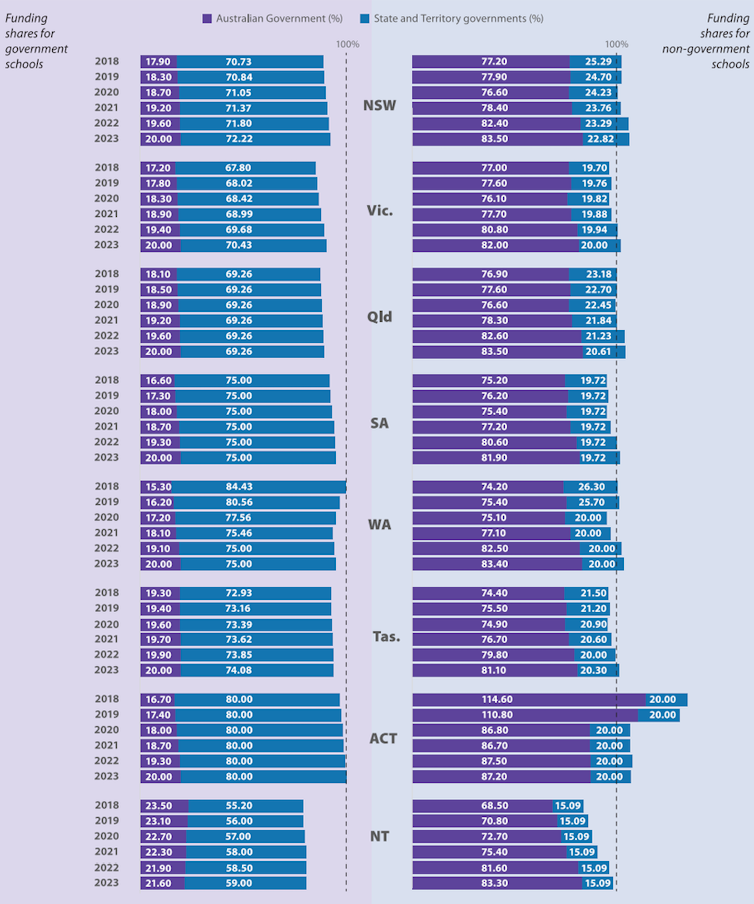When Prime Minister Anthony Albanese declared victory on election night, he said he wanted to unite Australians around “our shared values of fairness and opportunity, and hard work and kindness to those in need”.
So what would this look like in Australian schools? Schools, after all, are where a society that believes in fairness and opportunity must begin. Equity involves more than fairly funding schools.
It is about matching teachers’ passion with the respect, time, resources and conditions that enable them to do what they signed up to do: make a difference in students’ lives.
Based on our research into quality use of evidence do drive quality in education, I suggest equity, hard work and kindness should underpin school policy in three ways.
1. Ensure fairness in funding
The first priority is fairness in funding. It has been ten years since the Gonski review proposed a more equitable approach to school funding. The goal was to ensure differences in students’ educational outcomes are not the product of differences in wealth, income or power.
Since then, the approach has been diluted and gone backwards.
While resourcing to schools increased by over A$2 billion over a decade, the Grattan Institute found that once wage growth is taken into account, private schools received over 80% of this extra funding despite educating less than 20% of Australia’s most disadvantaged students.
COVID-19 has intensified disparities that are hard-baked into Australia schooling through the historical segregation of schools.
The basis of the reform therefore needs to be reviewed. As then Prime Minister Julia Gillard, a former education minister, effectively tied a hand behind the government’s back by committing to the principle that no school would lose funding as a result of the reforms.
This distorted Gonski’s needs-based aspiration.
The needs-based funding that needs to be directed to public schools for them to be fully funded according to the Gonski model equates to more than $1,000 per student each year. But ensuring all schools get a fair share of public funding is only a part of the challenge.
Source: Review of needs‑based funding requirements: final report, December 2019/DESE, CC BY
2. Reward those who choose to teach
A second priority relates to fairly rewarding the hard work of teachers. This should include incentives to enter the profession, and better pay and working conditions to keep them there.
Teacher shortages are reaching critical levels. Modelling in Queensland, for example, shows a 25% decline in state high school teaching graduates over five years. Secondary school enrolments are predicted to increase by 13% over the same period.
As Southern Cross University education professor Pasi Sahlberg notes, teachers “start excited and depart exhausted”.
During the campaign, Labor promised high-achieving students would be paid up to $12,000 a year to study education to lift teacher standards.
“We want to make sure our kids get the best education they can. That means we have to make sure they get the best-quality teaching,” Albanese said. nb moved this quote down
Labor also announced plans to double the number of high-achieving students enrolling in teacher education over the next decade, from around 1,800 a year at present to 3,600.
Also, about 5,000 students who receive an Australian Tertiary Admission Rank (ATAR) of 80 will be able to get an annual $10,000 payment over their four-year degree. An extra $2,000 a year has been promised to students who commit to teach in regional areas – the worst affected by teacher shortages. I think we can cut this par - it doubles up on above
Providing incentives like these might work – particularly as only 3% of high achievers in Australia select teaching for undergraduate study. Contrast this to the 19% who select science for undergraduate study.
Three decades ago, about tens times this proportion of high achievers chose to study teaching.
But, unlike other fields such as agriculture, such rankings year 12 exam marks? are less reliable as predicators of performance in education. It is rightly argued that other skills, such as high-level interpersonal skills, are important to the quality of teaching, alongside high-level literacy and numeracy.
We need to be thinking more boldly and expansively about how we can inspire and assess people to enter the profession.
3. Make schools better for teaching
But even if such measures might attract new teachers, attrition rates are also concerning.
Educators persistently indicate they are suffering stress, burnout, abuse from parents and excessive workload, which takes away from teaching students.
Increased workload pressures mean they have less time to focus on teaching students. It ultimately drives many out of teaching.
Strikes for better pay in New South Wales in relation to the government’s 2.5% wage cap for public servants are on one level about fair pay, but also reflect deeper concerns about working conditions.
Teachers do not feel respected. A 2020 study found nearly three-quarters of educators felt underappreciated.
The challenge of keeping teachers in the profession therefore entails much more than pay. Research has shown salary ranks after factors such as commitment to the profession, job satisfaction and positive relationships with students and colleagues. The most common reasons for leaving include workloads, being unappreciated, stress and burnout from years of struggle in substandard conditions.
Fostering excellence in teaching is therefore not just about attracting quality candidates, nor is it only about paying them at the right level once they become teachers. It’s about respecting their judgement and professionalism, as well as supporting them throughout their careers.
A great start on this front; the old teacher scholarships trained a generation of brilliant teachers and created amazing education opportunities for working class kids.
— Van Badham (@vanbadham) May 9, 2022
“Labor to announce scholarship plan for high-achieving students to become teachers” https://t.co/b4nzXew67N
Even though pay might be poor in comparison with other professions and the workload overwhelming, educators continue to teach because they are driven by a deep, passionate moral purpose to make a difference in kids’ lives.
We understand the challenges. Let’s hope kindness, fairness and a clear moral purpose drive the policy of Australia’s new government to address current problems as well as deeply embedded historical legacies.
The Albanese government has a tough, complex job – not unlike teaching.



 Silver Spikes to $62.89 on Fed Cut – But Weekly Bearish Divergence Flashes Caution: Don’t Chase, Wait for the Dip
Silver Spikes to $62.89 on Fed Cut – But Weekly Bearish Divergence Flashes Caution: Don’t Chase, Wait for the Dip  Asia’s IPO Market Set for Strong Growth as China and India Drive Investor Diversification
Asia’s IPO Market Set for Strong Growth as China and India Drive Investor Diversification  Austria’s AA Credit Rating Affirmed as Fitch Highlights Stable Outlook
Austria’s AA Credit Rating Affirmed as Fitch Highlights Stable Outlook  Fed Near Neutral Signals Caution Ahead, Shifting Focus to Fixed Income in 2026
Fed Near Neutral Signals Caution Ahead, Shifting Focus to Fixed Income in 2026  ETH Bulls Smash Trendline – $4,000 Next as Whale Squeeze Tightens
ETH Bulls Smash Trendline – $4,000 Next as Whale Squeeze Tightens  Morgan Stanley Downgrades Tesla as AI Growth Expectations Rise
Morgan Stanley Downgrades Tesla as AI Growth Expectations Rise 

































